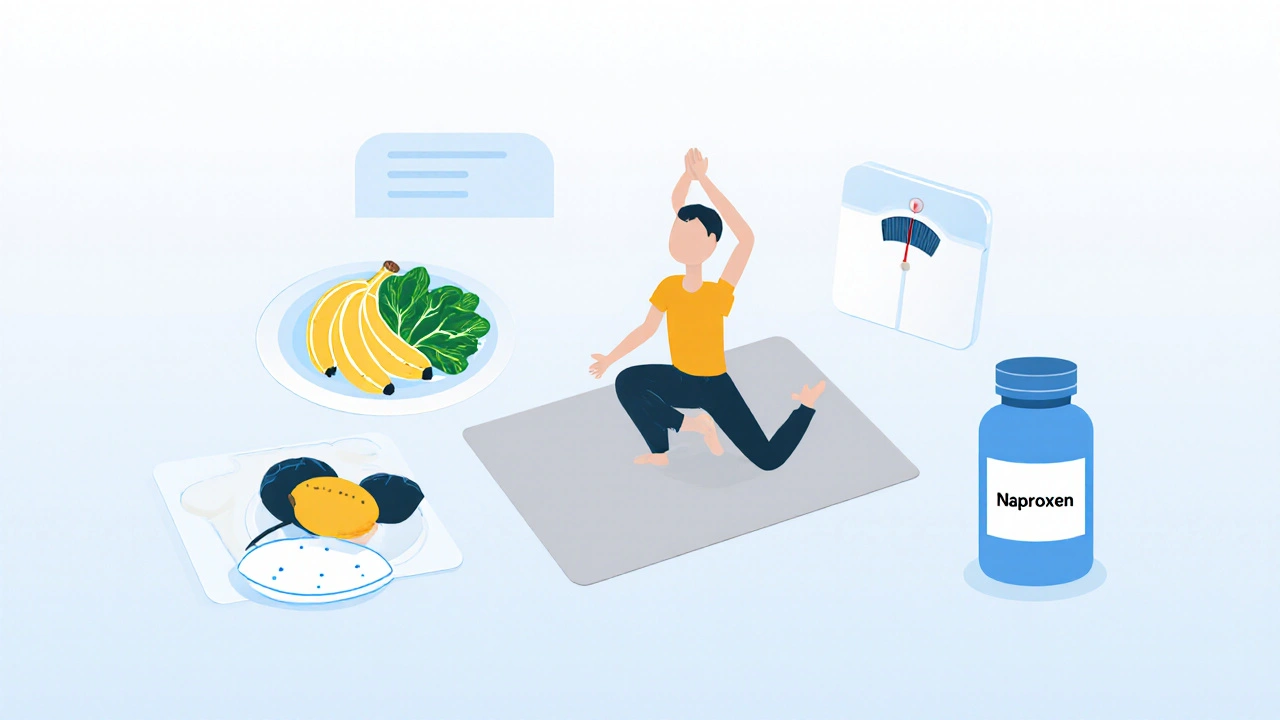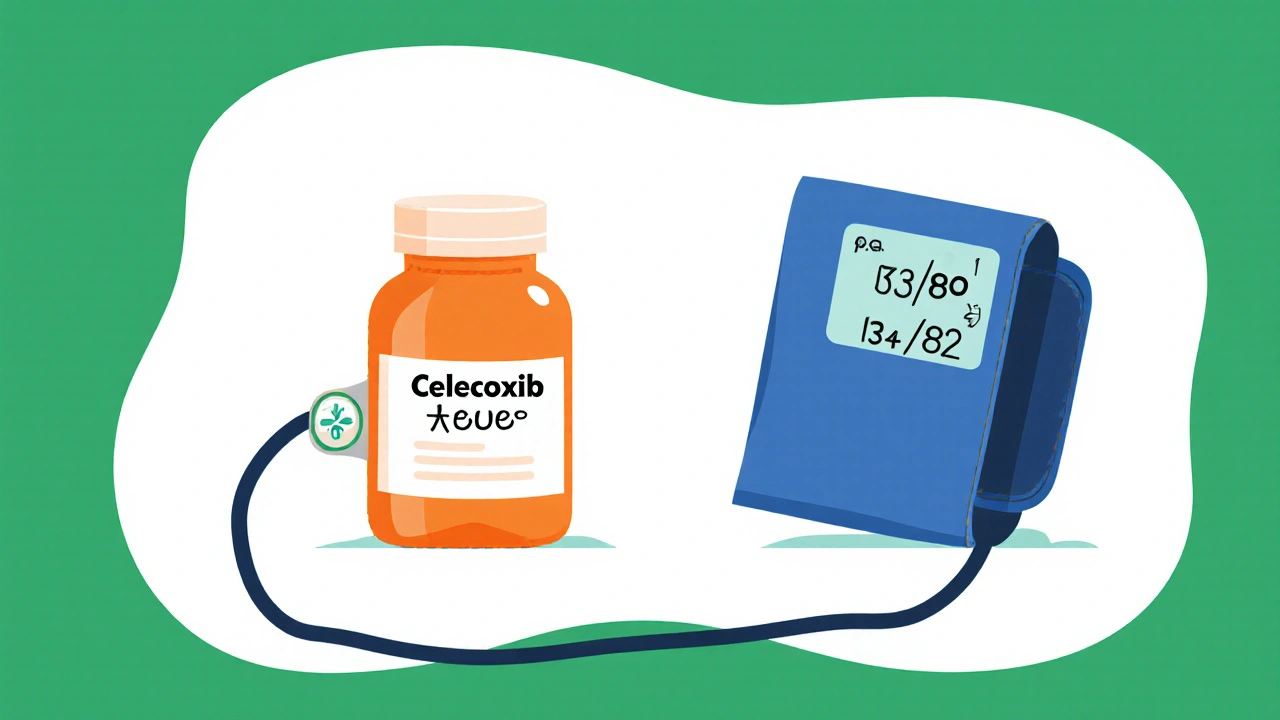Celecoxib Blood Pressure Estimator
How It Works
Based on clinical studies, celecoxib may increase blood pressure by 2-4 mmHg systolic and 1-3 mmHg diastolic. Your personal risk depends on your current BP and health factors.
Estimated New Blood Pressure
Systolic: N/A mmHg
Diastolic: N/A mmHg
Next Steps
When it comes to pain relief, Celecoxib is often praised for being a selective COX‑2 inhibitor that spares the stomach compared with traditional NSAIDs. But many people wonder: Celecoxib and blood pressure-what’s the real link? This article breaks down the science, who’s most vulnerable, and how you can keep your numbers in check while staying comfortable.
How Celecoxib Works
Celecoxib blocks the enzyme cyclo‑oxygenase‑2 (COX‑2), which is a key player in producing prostaglandins-chemicals that drive pain and inflammation. By targeting COX‑2 specifically, the drug aims to reduce inflammation without the gastrointestinal side effects common to non‑selective NSAIDs like ibuprofen or naproxen.
While this selectivity sounds perfect, COX‑2 also participates in regulating blood flow in the kidneys. When that pathway is altered, the body may retain sodium and water, nudging blood pressure upward.
Impact on Blood Pressure
Large‑scale clinical trials and post‑marketing studies have shown a modest but consistent rise in systolic and diastolic blood pressure among users of celecoxib, especially at doses of 400mg daily or higher.
- Average systolic increase: 2‑4mmHg.
- Average diastolic increase: 1‑3mmHg.
- Effect is dose‑dependent and more noticeable in people already diagnosed with hypertension.
Compared with other NSAIDs, celecoxib’s impact sits between ibuprofen (slightly higher increase) and naproxen (often neutral). The difference matters for patients whose Blood Pressure is already at the edge of normal.
Who Is Most at Risk?
Not everyone experiences a blood‑pressure jump. The biggest risk factors include:
- Pre‑existing hypertension: Even mild hypertension can become harder to control.
- Age over 65: Kidney function naturally declines, amplifying sodium retention.
- Concurrent use of antihypertensive drugs such as ACE inhibitors, ARBs, or diuretics, which may interact with the renal effects of celecoxib.
- High‑salt diet or poor lifestyle habits that already strain the renin‑angiotensin system.
- Kidney disease: Reduced glomerular filtration makes any extra sodium load a bigger problem.
Patients taking other NSAIDs (e.g., ibuprofen, naproxen, aspirin) alongside celecoxib should also be cautious, as the combined effect can amplify blood‑pressure changes.
Monitoring Blood Pressure While on Celecoxib
For anyone starting or already on celecoxib, regular monitoring is essential. Here’s a practical routine:
- Baseline check: Record systolic and diastolic numbers before the first dose.
- Weekly self‑checks for the first month: Use a validated home cuff, record morning readings.
- Monthly clinician review for the first three months, then quarterly if stable.
- Watch for symptoms like headaches, swelling, or dizziness, which may signal rising pressure.
If your systolic climbs above 140mmHg or diastolic above 90mmHg and stays there for two consecutive readings, talk to your doctor about adjusting the dose or switching therapy.
Managing the Risk: Alternatives & Lifestyle
When the blood‑pressure rise becomes a concern, consider these options:
- Switch to naproxen for patients who tolerate it well; studies show a neutral effect on BP for many.
- Use acetaminophen for mild to moderate pain when inflammation isn’t the primary issue.
- Physical therapy and low‑impact exercises (e.g., swimming, yoga) can reduce reliance on medication.
- Dietary tweaks: Reduce sodium to <1500mg/day, increase potassium‑rich foods (bananas, spinach) to offset sodium retention.
- Weight management: Losing just 5% of body weight can lower systolic pressure by 5‑8mmHg.
Always discuss any change with your healthcare provider. Some patients may need a short taper period to avoid rebound pain.

Quick Comparison of NSAIDs and Blood Pressure
| Drug | Systolic ↑ | Diastolic ↑ | Typical Dose | Notes |
|---|---|---|---|---|
| Celecoxib | 2‑4 | 1‑3 | 200‑400mg/day | Selective COX‑2; more impact on kidneys. |
| Ibuprofen | 3‑5 | 2‑4 | 400‑800mg q6‑8h | Non‑selective; higher GI risk. |
| Naproxen | 0‑2 | 0‑2 | 250‑500mg BID | Often neutral on BP; longer half‑life. |
| Aspirin (low‑dose) | ‑1‑0 | ‑1‑0 | 81mg/day | Cardioprotective; minimal BP effect. |
Key Takeaways Checklist
- Celecoxib can raise systolic pressure by 2‑4mmHg and diastolic by 1‑3mmHg.
- Risk spikes in older adults, those with existing hypertension, kidney disease, or high‑salt diets.
- Baseline and regular home BP monitoring are vital during the first three months.
- If BP climbs above 140/90mmHg, discuss dose reduction, alternative NSAIDs, or non‑pharmacologic pain management.
- Adopt lifestyle tweaks-lower sodium, stay active, and maintain a healthy weight-to offset medication‑induced rises.
Frequently Asked Questions
Can I take celecoxib if I already have high blood pressure?
Yes, but do it under close medical supervision. Your doctor should check your blood pressure before starting, use the lowest effective dose, and monitor weekly for the first month.
How quickly does celecoxib affect blood pressure?
Changes can appear within a week of consistent dosing, though the most noticeable shift usually occurs after 2‑3 weeks.
Is the blood‑pressure rise permanent?
No. If you stop the drug or switch to a neutral NSAID, the pressure typically returns to baseline within a few days to a week, provided kidney function remains normal.
Should I avoid other NSAIDs while on celecoxib?
Avoid combining with other NSAIDs unless a doctor advises it. The combined sodium‑retaining effect can push blood pressure higher and increase GI risk.
What lifestyle steps help keep my blood pressure stable on celecoxib?
Limit sodium to<1500mg/day, eat plenty of fruits and vegetables, stay active (30min most days), maintain a healthy weight, and keep up with regular BP checks.

alex montana
October 17, 2025 AT 21:00